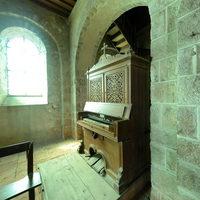Overview
In the twelfth century this town marked the border between lands to the west controlled by the Plantagenets and a little seigneurie reporting to the seigneurs de Bourbon. Built not long after the construction of the Donjon de la Toque the church of Notre-Dame in Huriel was then part of a priory dependant upon the monastery of Déols and the diocese of Bourges. With its spacious wooden-roofed single-vessel nave and vaulted crossing space and transept arms, Notre-Dame of Huriel conforms to the type sometimes called berrichonne. The nave windows are set high; the exterior wall is stiffened with buttresses strips; the interior nave is unarticulated. To the west is a narthex with upper chapel reached by interior stairs. To the east an octagonal central tower is supported by crossing piers with squinches effecting the transition from square to octagon. Narrow passages are left between the western crossing piers and the nave walls. The articulation of the exterior east end is particularly powerful with its hierarchy of triple apses; tall transept arms and central choir, surmounted by a crossing tower with octagonal drum decorated with blind arcades surmounted by a wooden steeple comparable to the one at Néris-les-Bains.

